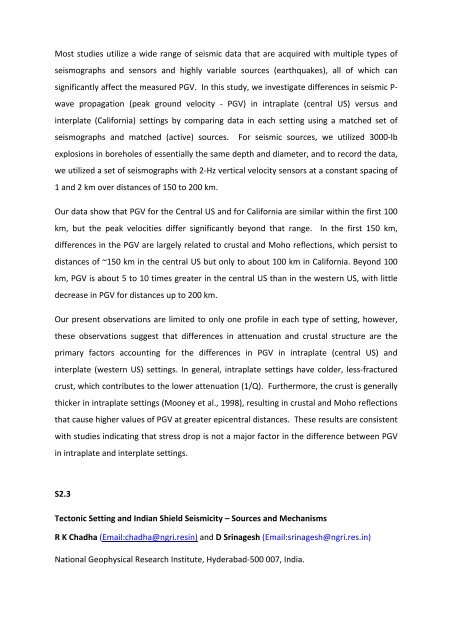indo–us workshop on “intraplate seismicity†- The CERI Blog
indo–us workshop on “intraplate seismicity†- The CERI Blog
indo–us workshop on “intraplate seismicity†- The CERI Blog
You also want an ePaper? Increase the reach of your titles
YUMPU automatically turns print PDFs into web optimized ePapers that Google loves.
Most studies utilize a wide range of seismic data that are acquired with multiple types of<br />
seismographs and sensors and highly variable sources (earthquakes), all of which can<br />
significantly affect the measured PGV. In this study, we investigate differences in seismic P-‐<br />
wave propagati<strong>on</strong> (peak ground velocity -‐ PGV) in intraplate (central US) versus and<br />
interplate (California) settings by comparing data in each setting using a matched set of<br />
seismographs and matched (active) sources. For seismic sources, we utilized 3000-‐lb<br />
explosi<strong>on</strong>s in boreholes of essentially the same depth and diameter, and to record the data,<br />
we utilized a set of seismographs with 2-‐Hz vertical velocity sensors at a c<strong>on</strong>stant spacing of<br />
1 and 2 km over distances of 150 to 200 km.<br />
Our data show that PGV for the Central US and for California are similar within the first 100<br />
km, but the peak velocities differ significantly bey<strong>on</strong>d that range. In the first 150 km,<br />
differences in the PGV are largely related to crustal and Moho reflecti<strong>on</strong>s, which persist to<br />
distances of ~150 km in the central US but <strong>on</strong>ly to about 100 km in California. Bey<strong>on</strong>d 100<br />
km, PGV is about 5 to 10 times greater in the central US than in the western US, with little<br />
decrease in PGV for distances up to 200 km.<br />
Our present observati<strong>on</strong>s are limited to <strong>on</strong>ly <strong>on</strong>e profile in each type of setting, however,<br />
these observati<strong>on</strong>s suggest that differences in attenuati<strong>on</strong> and crustal structure are the<br />
primary factors accounting for the differences in PGV in intraplate (central US) and<br />
interplate (western US) settings. In general, intraplate settings have colder, less-‐fractured<br />
crust, which c<strong>on</strong>tributes to the lower attenuati<strong>on</strong> (1/Q). Furthermore, the crust is generally<br />
thicker in intraplate settings (Mo<strong>on</strong>ey et al., 1998), resulting in crustal and Moho reflecti<strong>on</strong>s<br />
that cause higher values of PGV at greater epicentral distances. <strong>The</strong>se results are c<strong>on</strong>sistent<br />
with studies indicating that stress drop is not a major factor in the difference between PGV<br />
in intraplate and interplate settings.<br />
S2.3<br />
Tect<strong>on</strong>ic Setting and Indian Shield Seismicity – Sources and Mechanisms<br />
R K Chadha (Email:chadha@ngri.resin) and D Srinagesh (Email:srinagesh@ngri.res.in)<br />
Nati<strong>on</strong>al Geophysical Research Institute, Hyderabad-‐500 007, India.


